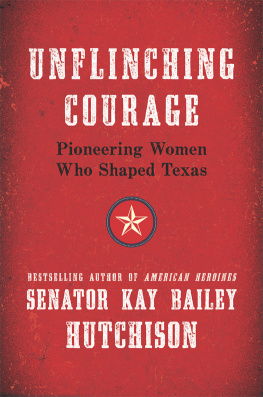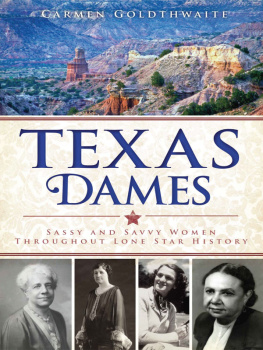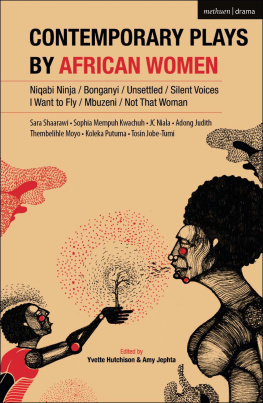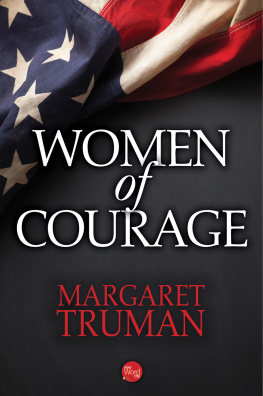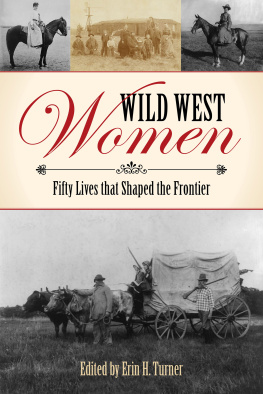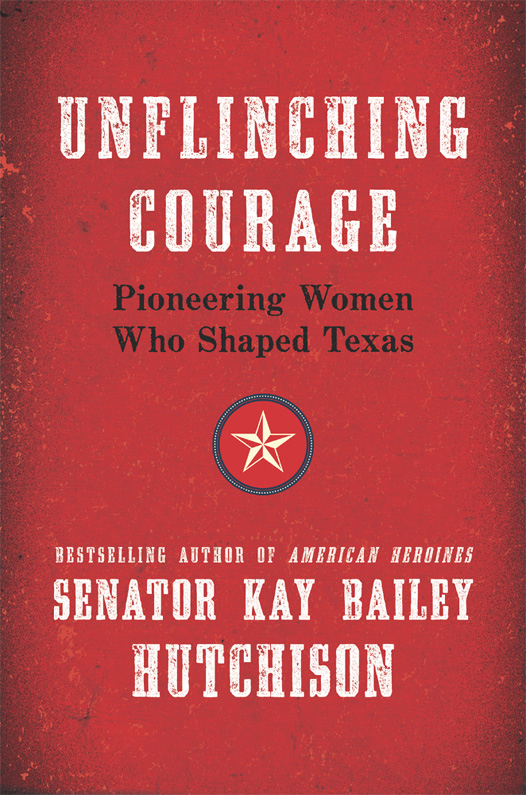Unflinching Courage
Leading Ladies
American Heroines
Nine and Counting: The Women of the Senate (coauthor)
This book is dedicated to my children, Kathryn Bailey Hutchison and Houston Taylor Hutchison. I hope the nineteenth-century pioneers who faced obstacles with unflinching courage and in so doing built our great state and nation will be an inspiration to them and to their generation.
Contents
N o one can write a book alone; there are so many archivists, librarians, editors, researchers, and experts brains to pick that it invariably becomes a collaboration.
My research writer, Howard Cohn, is the easiest person with whom to work. He does excellent research and I trust his judgment. My editor, Claire Wachtel, was eager to publish the stories of early pioneer women, and her commitment to ensuring that the role of women is preserved in American history has been proven through the years. She has edited the fabulous books Cokie Roberts has written, and this is the third one she has done with me that adds to the chronicles that will be read by future generations documenting how Americas exceptionalism developed.
Howard and I started our journey to uncover the women who arent widely known but contributed so much to the building of Texas, and to add to those who were already in the history books.
Noted Texas historians gave generously of their time. Ted Fehrenbach is the father of Texas historians in this generation. We gained insight from him and potential sources to further explore. Don Carleton, director of the Dolph Briscoe Center for American History at the University of Texas; Frances Vick, historian, author, and former president of the Texas State Historical Association; and the late Archie McDonald, preeminent East Texas historian, author, and professor at Stephen F. Austin State University, all gave us valuable suggestions, on subjects and research sites. Linda Reynolds, director of the East Texas Research Center at Stephen F. Austin State University, copied many papers and letters from which we gained additional knowledge of several women profiled in the Texas Revolution chapter. Carolyn Spears, curator at the Stone Fort Museum, took time to show me Anna Raguet Irions wedding dress and that of her daughter Harriet Raguet Taylor, which have been beautifully preserved and stored in the Stone Fort Museum, on the campus of Stephen F. Austin State University in Nacogdoches.
One set of letters referenced by Archie and Linda included correspondence of Thomas J. Rusk that I was able to trace to the El Paso Public Library. It was there, through the generous help of the Border Heritage librarian, Marta Estrada, and the library information specialist, Claudia Ramirez, that I found the original suicide letter written by Senator Rusk to his children, explaining his despondency.
J. P. (James Perry) Bryan and Stephen C. Cook, descendants of Emily Austin Bryan Perry, gave me more family information that added depth to her profile.
Luci Johnson, while giving my children and me a tour of the LBJ Ranch in the Lyndon B. Johnson National Historical Park, introduced me to the story of Eliza Bunton Johnson, her great-grandmother, who became a wonderful addition to the Trail Drives and Ranches chapter.
When I wrote to my friends Tres Kleberg and Jamey Clement, descendants of Henrietta King, to ask for more information about her, they and Helen Kleberg Groves were immensely helpful.
Dr. Linda Sundquist, who wrote the definitive biography of Mary Shindler, helped me find some of her literary works and personal writing that highlighted her amazing life.
Dianne Garrett Powell, whose family gave the University of Texas at Arlington historic Texas maps and documents, among them the Irion family papers that include letters from my great-great-grandfather, Charles S. Taylor, added confirmation of some of the most interesting facets of Anna Raguet Irions life. Dianne is a past president of the Texas State Historical Association.
Betty Sharp Adcock, another descendant of Dr. Frank Sharp, sent me a copy of the obituary of Martha Hall Sharp that documented her early death in Tennessee, while visiting her family after her move to San Augustine.
Barbara Tucker Mitchell, my second cousin, also provided great help with the family tree of the Sharp family, from the historical records in San Augustine County.
Former lieutenant governor of Texas Bill Hobby and his children, Paul Hobby and Laura Hobby Beckworth, gave me several citations, which greatly enriched the chapter about Oveta Culp Hobby.
Pattye Greer, my longtime friend and a former member of the Stephen F. Austin State University Board of Regents, was immensely helpful in locating the photograph of Polly Rusk.
David Zepeda, of the Briscoe Center, contributed invaluable maps to illustrate the life of Jane Long, the Austin Family, the major battles of the Texas Revolution, and the cattle trails to points north.
Finally, Melinda Poucher helped edit the chapters as they were written and has a future career as a major writer or editor, if she chooses that route. She caught many a mistake or repetition that I missed. I couldnt have done it without her, and... it was she who thought of the title!
T he Spirit of Texas has been cussed and discussed throughout its storied history. Texans are ruggedly independent, fiercely loyal, colorful, fun-loving, and entrepreneurial.
There could be a thousand different reasons given for the unique Texas persona, but I believe it boils down to two major features of our history. First, Texas, alone among the states, fought single-handedly for its independence. Like the Americans who rebelled against oppressive British rule, Texans rose up against the Mexican dictator Santa Anna. The building of a new republic in 1836 marked the beginning of an independent streak that has been passed through the generations. What began as a republic led to statehood in 1845.
The second way our ancestors evinced their Texas spirit was by conquering the harsh land. As the famous Texas historian T. R. Fehrenbach noted, the Anglo frontier in Texas was not a frontier of traders, trappers and soldiers, as in most other states. It was a frontier of farming families, with women and small children, encroaching and colliding with a long-ranging, barbaric, war-making race. Though Indian wars were common in other states, in Texas they lasted for more than forty years, and the torture doled out by Comanche tribes in particular spared no one. In their attempts to run the settlers out of their hunting and grazing lands, the Indians not only attacked the men, they also made examples of the women, the children, and the elderly.
The nineteenth century put its stamp on the Texas mystique. The early half was dominated by the revolution and the second half by the settling of the unforgiving land.
Contributions by women to the building of the state were crucial to the resulting spirit. To call those pioneer women rugged and resilient would be an understatement. Many of them came from southern states and genteel backgrounds. They were educated and had grown up in comfortable surroundings. They entered an untamed frontier with virtually no comforts or amenities. They followed their husbands, who sought to make their own way mostly because of the cheap or free land. They lived in crude log cabins or even mud huts, had little furniture, and made the most of their utensils, clothes, and necessities. They were threatened by weather, revolution, and Indian raids, and a few even endured arduous trail drives, herding cattle to markets thousands of miles away.

